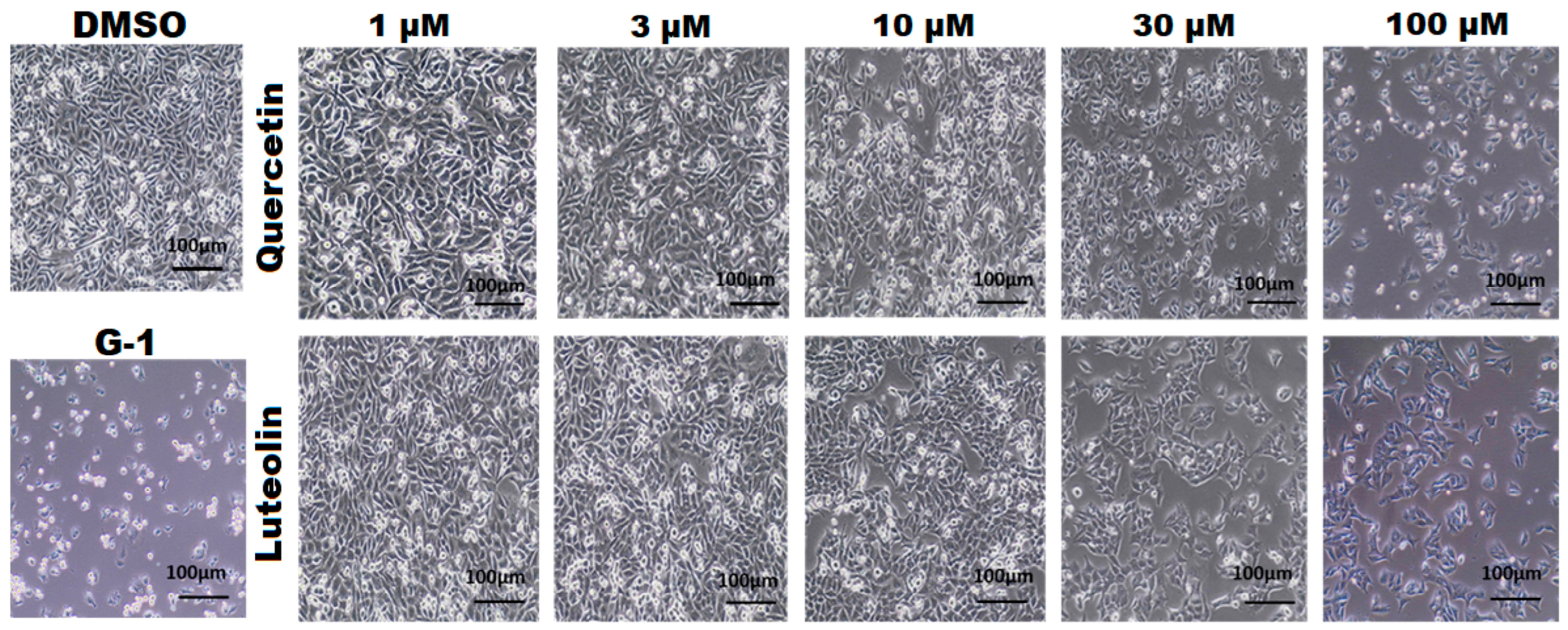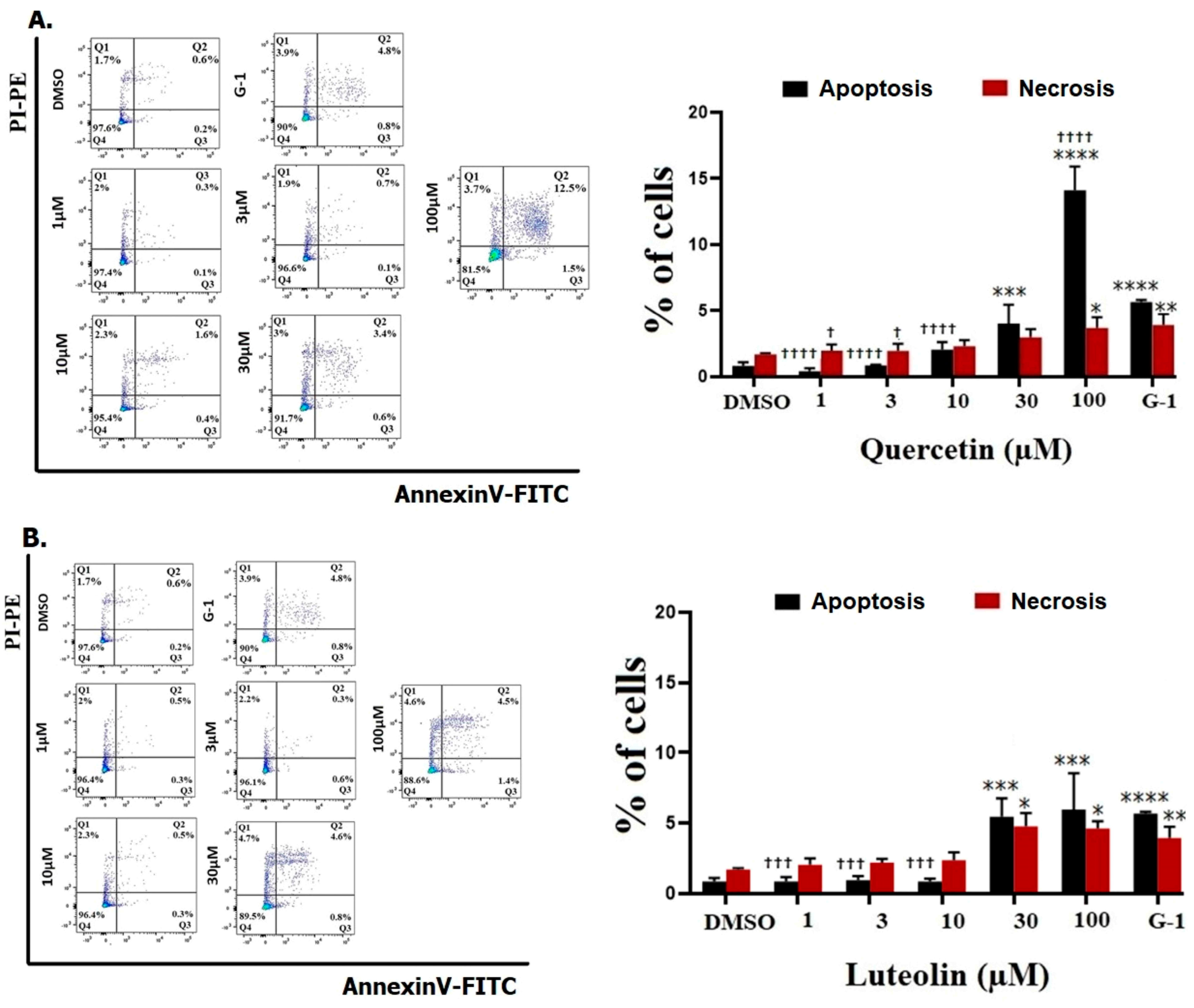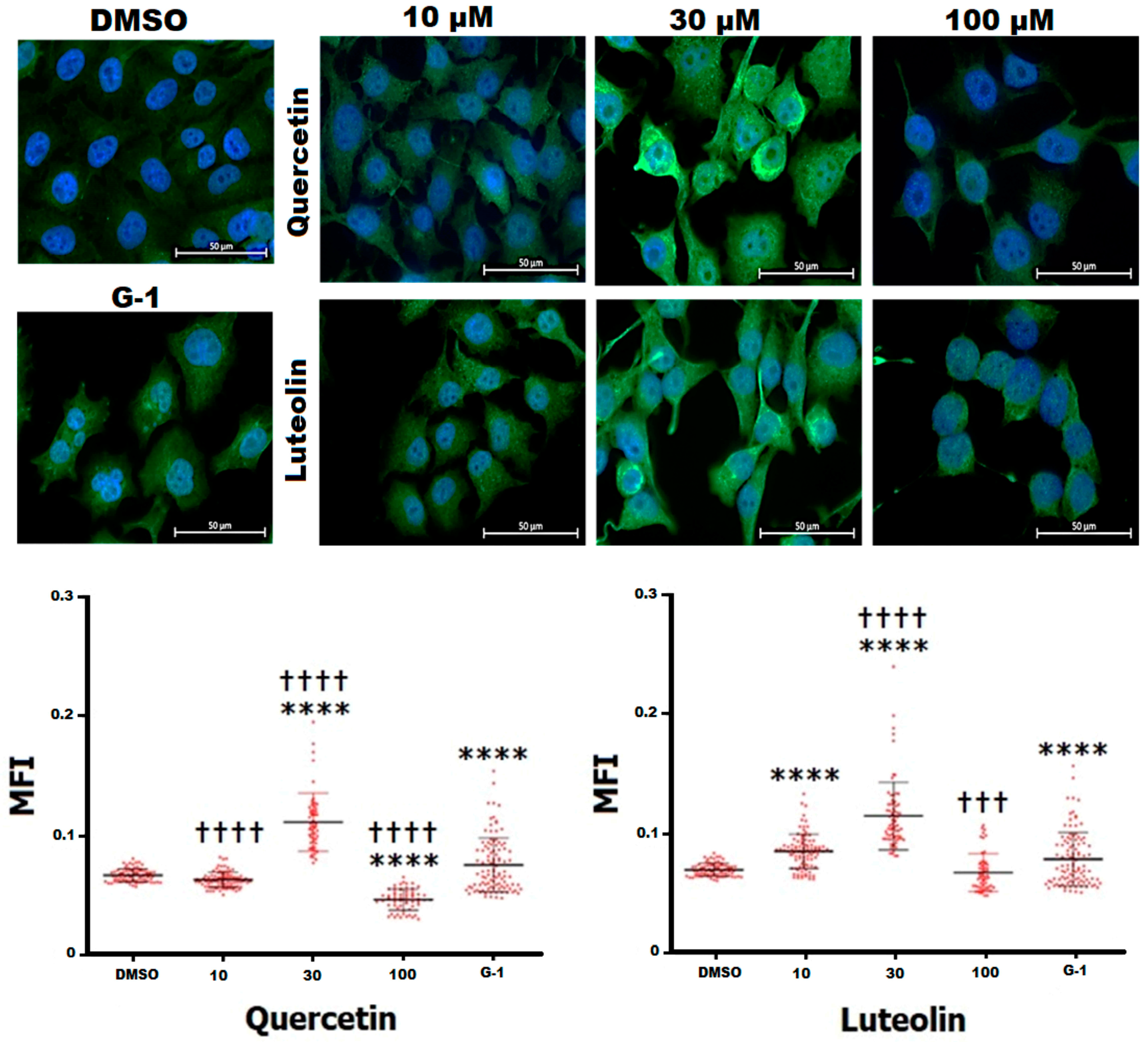Antitumor Effects of Quercetin and Luteolin in A375 Cutaneous Melanoma Cell Line Are Mediated by Upregulation of P-ERK, c-Myc, and the Upstream GPER
Abstract
1. Introduction
2. Materials and Methods
2.1. Cell Line and Culture Conditions
2.2. Chemicals and Preparation
2.3. Cell Viability Assay
2.4. Cell Morphology
2.5. Flow Cytometry
2.5.1. Apoptosis Assay
2.5.2. Cell Cycle Assay
2.6. Transwell Migration Assay
2.7. Immunofluorescence (IF) Assay
2.8. Immunoblotting Assay
2.9. Statistical Analysis
3. Results
3.1. Cell Viability
3.2. Morphological Changes in Melanoma Cell Lines
3.3. Flowcytometry
3.3.1. Apoptosis/Necrosis Quantification
3.3.2. Cell Cycle Analysis
3.4. Migration of Melanoma Cells
3.5. Immunofluorescence (IF) Staining of GPER
3.6. Western Blot
4. Discussion
5. Conclusions
Supplementary Materials
Author Contributions
Funding
Institutional Review Board Statement
Informed Consent Statement
Data Availability Statement
Conflicts of Interest
References
- Hasan, N.; Nadaf, A.; Imran, M.; Jiba, Y.; Sheikh, A.; Almalki, W.H.; Almujri, S.S.; Mohammed, Y.H.; Kesharwani, P.; Ahmad, F.J. Skin Cancer: Understanding the Journey of Transformation from Conventional to Advanced Treatment Approaches. Mol. Cancer 2023, 22, 168. [Google Scholar] [CrossRef] [PubMed]
- Naqvi, M.; Gilani, S.Q.; Syed, T.; Marques, O.; Kim, H.C. Skin Cancer Detection Using Deep Learning—A Review. Diagnostics 2023, 13, 1911. [Google Scholar] [CrossRef] [PubMed]
- Caruntu, C.; Mirica, A.; Roșca, A.E.; Mirica, R.; Caruntu, A.; Tampa, M.; Matei, C.; Constantin, C.; Neagu, M.; Badarau, A.I.; et al. The Role of Estrogens and Estrogen Receptors in Melanoma Development and Progression. Acta Endocrinol. 2016, 12, 234–241. [Google Scholar] [CrossRef]
- Lopes, J.; Rodrigues, C.M.P.; Gaspar, M.M.; Reis, C.P. Melanoma Management: From Epidemiology to Treatment and Latest Advances. Cancers 2022, 14, 4652. [Google Scholar] [CrossRef] [PubMed]
- Marzagalli, M.; Marelli, M.M.; Casati, L.; Fontana, F.; Moretti, R.M.; Limonta, P. Estrogen Receptor β in Melanoma: From Molecular Insights to Potential Clinical Utility. Front. Endocrinol. 2016, 7, 140. [Google Scholar] [CrossRef]
- Smetana, K.; Lacina, L.; Kodet, O. Targeted Therapies for Melanoma. Cancers 2020, 12, 2494. [Google Scholar] [CrossRef]
- Mahmoodzadeh, S.; Dworatzek, E. The Role of 17β-Estradiol and Estrogen Receptors in Regulation of Ca2+ Channels and Mitochondrial Function in Cardiomyocytes. Front. Endocrinol. 2019, 10, 310. [Google Scholar] [CrossRef]
- Marzagalli, M.; Casati, L.; Moretti, R.M.; Marelli, M.M.; Limonta, P. Estrogen Receptor β Agonists Differentially Affect the Growth of Human Melanoma Cell Lines. PLoS ONE 2015, 10, e0134396. [Google Scholar] [CrossRef]
- Périan, S.; Vanacker, J.M. GPER as a Receptor for Endocrine-Disrupting Chemicals (EDCs). Front. Endocrinol. 2020, 19, 545. [Google Scholar] [CrossRef]
- Bautista, D.S.; Olivares, A.; Gonzalez, P.C.; Bonilla, E.; Salazar, Z.; Solis, M.A.P. GPR30 Expression and Function in Breast Cancer Cells Are Induced through a Cis-Acting Element Targeted by ETS Factors. Oncol. Rep. 2020, 43, 1669–1682. [Google Scholar]
- Zhou, L.; Yu, T.; Yang, F.; Han, J.; Zuo, B.; Huang, L.; Bai, X.; Jiang, M.; Wu, D.; Chen, S.; et al. G Protein-Coupled Estrogen Receptor Agonist G-1 Inhibits Mantle Cell Lymphoma Growth in Preclinical Models. Front. Oncol. 2021, 11, 668617. [Google Scholar] [CrossRef] [PubMed]
- Jung, J. Role of G Protein-Coupled Estrogen Receptor in Cancer Progression. Toxicol. Res. 2019, 35, 209–214. [Google Scholar] [CrossRef] [PubMed]
- Luo, J.; Liu, D. Does GPER Really Function as a G Protein-Coupled Estrogen Receptor in Vivo? Front. Endocrinol. 2020, 11, 148. [Google Scholar] [CrossRef] [PubMed]
- Feldman, R.D.; Limbird, L.E. GPER (GPR30): A Nongenomic Receptor (GPCR) for Steroid Hormones with Implications for Cardiovascular Disease and Cancer. Annu. Rev. Pharmacol. Toxicol. 2017, 57, 567–584. [Google Scholar] [CrossRef]
- Prossnitz, E.R.; Barton, M. The G Protein-Coupled Oestrogen Receptor GPER in Health and Disease: An Update. Nat. Rev. Endocrinol. 2023, 19, 407–424. [Google Scholar] [CrossRef]
- Arterburn, J.B.; Prossnitz, E.R. G Protein–Coupled Estrogen Receptor GPER: Molecular Pharmacology and Therapeutic Applications. Annu. Rev. Pharmacol. Toxicol. 2023, 57, 567–584. [Google Scholar] [CrossRef]
- Chavda, V.P.; Chaudhari, A.Z.; Balar, P.C.; Gholap, A.; Vora, L.K. Phytoestrogens: Chemistry, Potential Health Benefits, and Their Medicinal Importance. Phytother. Res. 2024, 38, 3060–3079. [Google Scholar] [CrossRef]
- Huang, Z.; Fang, F.; Wang, J.; Wong, C.W. Structural Activity Relationship of Flavonoids with Estrogen-Related Receptor Gamma. FEBS Lett. 2010, 584, 22–26. [Google Scholar] [CrossRef]
- Harris, Z.; Donovan, M.G.; Branco, G.M.; Limesand, K.H.; Burd, R. Quercetin as an Emerging Anti-Melanoma Agent: A Four-Focus Area Therapeutic Development Strategy. Front. Nutr. 2016, 3, 48. [Google Scholar] [CrossRef]
- Kashyap, D.; Tuli, H.; Garg, V.; Bhatnagar, S.; Sharma, A. Ursolic Acid and Quercetin: Promising Anticancer Phytochemicals with Antimetastatic and Antiangiogenic Potential. Tumor Microenv. 2018, 1, 9–15. [Google Scholar]
- Hisaka, T.; Sakai, H.; Sato, T.; Goto, Y.; Nomura, Y.; Fukutomi, S.; Fujita, F.; Mizobe, T.; Nakashima, O.; Tanigawa, M.; et al. Quercetin Suppresses Proliferation of Liver Cancer Cell Lines in Vitro. Anticancer Res. 2020, 40, 4695–4700. [Google Scholar] [CrossRef]
- Aghababaei, F.; Hadidi, M. Recent Advances in Potential Health Benefits of Quercetin. Pharmaceuticals 2023, 16, 1020. [Google Scholar] [CrossRef] [PubMed]
- Soll, F.; Ternent, C.; Berry, I.M.; Kumari, D.; Moore, T.C. Quercetin Inhibits Proliferation and Induces Apoptosis of B16 Melanoma Cells in Vitro. Assay Drug Dev. Technol. 2020, 18, 261–268. [Google Scholar] [CrossRef]
- Kim, S.H.; Yoo, E.S.; Woo, J.S.; Han, S.H.; Lee, J.H.; Jung, S.H.; Kim, S.J.; Jung, J.Y. Antitumor and Apoptotic Effects of Quercetin on Human Melanoma Cells Involving JNK/P38 MAPK Signaling Activation. Eur. J. Pharmacol. 2019, 860, 172568. [Google Scholar] [CrossRef] [PubMed]
- Maggiolini, M.; Vivacqua, A.; Fasanella, G.; Recchia, A.G.; Sisci, D.; Pezzi, V.; Montanaro, D.; Musti, A.M.; Picard, D.; Andò, S. The G Protein-Coupled Receptor GPR30 Mediates c-fos Up-Regulation by 17β-Estradiol and Phytoestrogens in Breast Cancer Cells. J. Biol. Chem. 2004, 279, 27008–27016. [Google Scholar] [CrossRef] [PubMed]
- Masuhara, M.; Tsukahara, T.; Tomita, K.; Furukawa, M.; Miyawaki, S.; Sato, T. A Relation between Osteoclastogenesis Inhibition and Membrane-Type Estrogen Receptor GPR30. Biochem. Biophys. Rep. 2016, 3, 389–394. [Google Scholar] [CrossRef][Green Version]
- Almatroodi, S.A.; Almatroudi, A.; Alharbi, H.O.A.; Khan, A.A.; Rahmani, A.H. Effects and Mechanisms of Luteolin, a Plant-Based Flavonoid, in the Prevention of Cancers via Modulation of Inflammation and Cell Signaling Molecules. Molecules 2024, 29, 1093. [Google Scholar] [CrossRef]
- Ruan, J.; Zhang, L.; Yan, L.; Liu, Y.; Yue, Z.; Chen, L.; Wang, A.Y.; Chen, W.; Zheng, S.; Wang, S.; et al. Inhibition of Hypoxia-Induced Epithelial Mesenchymal Transition by Luteolin in Non-Small Cell Lung Cancer Cells. Mol. Med. Rep. 2012, 6, 138–232. [Google Scholar]
- Shi, M.L.; Chen, Y.F.; Liao, H.F. Effect of Luteolin on Apoptosis and Vascular Endothelial Growth Factor in Human Choroidal Melanoma Cells. Int. J. Ophthalmol. 2021, 14, 186–193. [Google Scholar] [CrossRef]
- Arrigo, D.G.; Gianquinto, E.; Rossetti, G.; Cruciani, G.; Lorenzetti, S.; Spyrakis, F. Binding of Androgen- and Estrogen-Like Flavonoids to Their Cognate (Non) Nuclear Receptors: A Comparison by Computational Prediction. Molecules 2021, 26, 1613. [Google Scholar] [CrossRef]
- Sun, M.; Xie, H.F.; Tang, Y.; Lin, S.Q.; Li, J.M.; Sun, S.; Hu, X.L.; Huang, Y.X.; Shi, W.; Jian, D. G Protein-Coupled Estrogen Receptor Enhances Melanogenesis via cAMP-Protein Kinase (PKA) by Upregulating Microphthalmia-Related Transcription Factor-Tyrosinase in Melanoma. J. Steroid Biochem. Mol. Biol. 2016, 165, 236–246. [Google Scholar] [CrossRef] [PubMed]
- Zheng, H.; Triplett, K.D.; Prossnitz, E.R.; Hall, P.R.; Daly, S.M. G Protein-Coupled Estrogen Receptor Agonist G-1 Decreases ADAM10 Levels and NLRP3-Inflammasome Component Activation in Response to Staphylococcus Aureus Alpha Hemolysin. Microbiol. Open 2024, 13, e23. [Google Scholar] [CrossRef] [PubMed]
- Hall, K.A.; Filardo, E.J. The G Protein-Coupled Estrogen Receptor (GPER): A Critical Therapeutic Target for Cancer. Cells 2023, 12, 2460. [Google Scholar] [CrossRef]
- Alwahsh, M.; Al-Doridee, A.; Jasim, S.; Awwad, O.; Hergenröder, R.; Hamadneh, L. Cytotoxic and Molecular Differences of Anticancer Agents on 2D and 3D Cell Culture. Mol. Biol. Rep. 2024, 51, 721. [Google Scholar] [CrossRef] [PubMed]
- Tarawneh, N.; Hamadneh, L.; Alshaer, W.; Al Bawab, A.Q.; Bustanji, Y.; Abdalla, S. Downregulation of aquaporins and PI3K/AKT and upregulation of PTEN expression induced by the flavone scutellarein in human colon cancer cell lines. Heliyon 2024, 10, e39402. [Google Scholar] [CrossRef]
- Moustogiannis, A.; Philippou, A.; Taso, O.; Zevolis, E.; Pappa, M.; Chatzigeorgiou, A.; Koutsilieris, M. The Effects of Muscle Cell Aging on Myogenesis. Int. J. Mol. Sci. 2021, 22, 3721. [Google Scholar] [CrossRef]
- Xie, F.; Zhou, X.; Su, P.; Li, H.; Tu, Y.; Du, J.; Pan, C.; Wei, X.; Zheng, M.; Jin, K.; et al. Breast Cancer Cell-Derived Extracellular Vesicles Promote CD8+ T Cell Exhaustion via TGF-β Type II Receptor Signaling. Nat. Commun. 2022, 13, 4461. [Google Scholar] [CrossRef]
- Bigdelou, Z.; Mortazavi, Y.; Saltanatpour, Z.; Asadi, K.M.; Johari, B. Role of Oct4–Sox2 Complex Decoy Oligodeoxynucleotides Strategy on Reverse Epithelial to Mesenchymal Transition (EMT) Induction in HT29 ShE Encompassing Enriched Cancer Stem Like Cells. Mol. Biol. Rep. 2020, 47, 1859–1869. [Google Scholar] [CrossRef]
- Black, M.; Arumugam, P.; Shukla, S.; Pradhan, A.; Ustiyan, V.; Milewski, D.; Kalinichenko, V.V.; Kalin, T.V. FOXM1 Nuclear Transcription Factor Translocates into Mitochondria and Inhibits Oxidative Phosphorylation. Mol. Biol. Cell 2020, 31, 1411–1424. [Google Scholar] [CrossRef]
- Ribeiro, M.P.C.; Santos, A.E.; Custódio, J.B.A. The Activation of the G Protein-Coupled Estrogen Receptor (GPER) Inhibits the Proliferation of Mouse Melanoma K1735-M2 Cells. Chem. Biol. Interact. 2017, 277, 176–184. [Google Scholar] [CrossRef]
- Guo, W.; Wang, H.; Li, C. Signal Pathways of Melanoma and Targeted Therapy. Signal Transduct. Target. Ther. 2021, 6, 424. [Google Scholar] [CrossRef] [PubMed]
- Ambrosini, G.; Natale, C.A.; Musi, E.; Garyantes, T.; Schwartz, G.K. The GPER Agonist LNS8801 Induces Mitotic Arrest and Apoptosis in Uveal Melanoma Cells. Cancer Res. Commun. 2023, 3, 540–547. [Google Scholar] [CrossRef]
- Hirtz, A.; Lebourdais, N.; Rech, F.; Bailly, Y.; Vaginay, A.; Tabbone, M.S.; Chneider, H.D.B.; Dumond, H. GPER Agonist G-1 Disrupts Tubulin Dynamics and Potentiates Temozolomide to Impair Glioblastoma Cell Proliferation. Cells 2021, 10, 3438. [Google Scholar] [CrossRef] [PubMed]
- Sadeghipour, M.M.; Nematollahi, M.H.; Ahmadinia, H.; Hajizadeh, M.R.; Mahmoodi, M. The Activation of the G-Protein-Coupled Estrogen Receptor Promotes the Aggressiveness of MDA-MB231 Cells by Targeting the IRE1α/TXNIP Pathway. Res. Pharm. Sci. 2024, 19, 606–621. [Google Scholar] [CrossRef] [PubMed]
- Azizi, E.; Fouladdel, S.; Movahhed, T.K.; Modaresi, F.; Barzegar, E.; Ghahremani, M.H.; Ostad, S.N.; Atashpour, S. Quercetin Effects on Cell Cycle Arrest and Apoptosis and Doxorubicin Activity in T47D Cancer Stem Cells. Asian Pac. J. Cancer Prev. 2022, 23, 4145–4154. [Google Scholar] [CrossRef]
- Fan, J.J.; Hsu, W.H.; Lee, K.H.; Chen, K.H.; Lin, C.W.; Lee, Y.L.A.; Ko, T.B.; Lee, L.T.; Lee, M.T.; Chang, M.S.; et al. Dietary Flavonoids Luteolin and Quercetin Inhibit Migration and Invasion of Squamous Carcinoma through Reduction of Src/Stat3/S100A7 Signaling. Antioxidants 2019, 8, 557. [Google Scholar] [CrossRef]
- Schomberg, J.; Wang, Z.; Farhat, A.; Guo, K.L.; Xie, J.; Zhou, Z.; Liu, J.; Kovacs, B.; Smith, F.L. Luteolin Inhibits Melanoma Growth in Vitro and In Vivo via Regulating ECM and Oncogenic Pathways but Not ROS. Biochem. Pharmacol. 2020, 177, 114025. [Google Scholar] [CrossRef]
- Cao, H.H.; Tse, A.K.W.; Kwan, H.Y.; Yu, H.; Cheng, C.Y.; Su, T.; Fong, W.H.; Yu, Z.L. Quercetin Exerts Anti-Melanoma Activities and Inhibits STAT3 Signaling. Biochem. Pharmacol. 2014, 87, 424–434. [Google Scholar] [CrossRef]
- Selenius, L.A.; Lundgren, M.W.; Jawad, R.; Danielsson, O.; Björnstedt, M. The Cell Culture Medium Affects Growth, Phenotype Expression and the Response to Selenium Cytotoxicity in A549 and HepG2 Cells. Antioxidants 2019, 8, 130. [Google Scholar] [CrossRef]
- Pei, S.N.; Lee, K.T.; Rau, K.M.; Lin, T.Y.; Tsai, T.H.; Hsu, Y.C. Luteolin (LUT) Induces Apoptosis and Regulates Mitochondrial Membrane Potential to Inhibit Cell Growth in Human Cervical Epidermoid Carcinoma Cells (Ca Ski). Biomedicines 2024, 12, 2330. [Google Scholar] [CrossRef]
- Li, N.; Wang, J. Quercetin induces cytotoxicity and apoptosis, reduces metastasis and drug resistance in oral cancer cells. Turk. J. Biochem. 2024, 49, 148–156. [Google Scholar] [CrossRef]
- Tsai, Y.D.; Chen, H.J.; Hsu, H.F.; Lu, K.; Liang, C.H.; Liliang, P.C.; Wang, K.W.; Wang, H.K.; Wang, C.P.; Houng, J.Y. Luteolin Inhibits Proliferation of Human Glioblastoma Cells via Induction of Cell Cycle Arrest and Apoptosis. J. Taiwan Inst. Chem. Eng. 2013, 44, 837–845. [Google Scholar] [CrossRef]
- Zhaorigetu, F.; Farrag, I.M.; Belal, A.; Al Badawi, M.H.; Abdelhady, A.A.; Abou Galala, F.M.A.; El-Sharkawy, A.; El-Dahshan, A.A.; Mehany, A.B.M. Antiproliferative, Apoptotic Effects and Suppression of Oxidative Stress of Quercetin Against Induced Toxicity in Lung Cancer Cells of Rats: In Vitro and In Vivo Study. J. Cancer 2021, 12, 5249–5259. [Google Scholar] [CrossRef] [PubMed]
- Cao, H.H.; Cheng, C.Y.; Su, T.; Fu, X.Q.; Guo, H.; Li, T.; Tse, A.K.W.; Kwan, H.Y.; Yu, H.; Yu, Z.L. Quercetin Inhibits HGF/c-Met Signaling and HGF Stimulated Melanoma Cell Migration and Invasion. Mol. Cancer 2015, 14, 103. [Google Scholar] [CrossRef] [PubMed]
- Yao, X.; Jiang, W.; Yu, D.; Yan, Z. Luteolin Inhibits Proliferation and Induces Apoptosis of Human Melanoma Cells In Vivo and In Vitro by Suppressing MMP-2 and MMP-9 through the PI3K/AKT Pathway. Food Funct. 2019, 10, 703–712. [Google Scholar] [CrossRef]
- Hanaf, D.; Onyenwoke, R.U.; Kimbro, K.S. The G-Protein-Coupled Estrogen Receptor Selective Agonist G-1 Attenuates Cell Viability and Migration in High-Grade Serous Ovarian Cancer Cell Lines. Int. J. Mol. Sci. 2024, 25, 6499. [Google Scholar] [CrossRef]
- Almeida, C.E.G.; Santerre, A.; Moreno, L.C.L.; Garcia, I.G.A.; Arellano, R.C.; Jimenez, S.H.D.; Jimenez, J.M.D. Proliferation and Apoptosis Regulation by G Protein–Coupled Estrogen Receptor in Glioblastoma C6 Cells. Oncol. Lett. 2022, 24, 217. [Google Scholar] [CrossRef]
- Rajagopal, S.; Shenoy, S.K. GPCR Desensitization: Acute and Prolonged Phases. Cell Signal. 2018, 41, 9–16. [Google Scholar] [CrossRef]
- Timofeev, O.; Giron, P.; Lawo, S.; Pichler, M.; Noeparast, M. ERK Pathway Agonism for Cancer Therapy: Evidence, Insights, and a Target Discovery Framework. Precis. Oncol. 2024, 8, 70. [Google Scholar] [CrossRef]
- Cagnol, S.; Chambard, J.C. ERK and Cell Death: Mechanisms of ERK-mediated cell death. Front. Cell Dev. Biol. 2010, 13, 2–21. [Google Scholar]
- Zhang, Y.; Ding, P.; Wang, Y.; Shao, C.; Guo, K.; Yang, H.; Feng, Y.; Ning, J.; Pan, M.; Wang, P.; et al. HDAC7/c-Myc signaling pathway promotes the proliferation and metastasis of choroidal melanoma cells. Cell Death Dis. 2023, 14, 38. [Google Scholar] [CrossRef] [PubMed]
- Natale, C.A.; Li, J.; Zhang, J.; Dahal, A.; Dentchev, T.; Stanger, B.Z.; Ridky, T.W. Activation of G Protein-Coupled Estrogen Receptor Signaling Inhibits Melanoma and Improves Response to Immune Checkpoint Blockade. eLife 2017, 7, e31770. [Google Scholar] [CrossRef] [PubMed]
- Edwards-Hicks, J.; Su, H.; Mangolini, M.; Yoneten, K.K.; Wills, J.; Rodriguez-Blanco, G.; Young, C.; Cho, K.; Barker, H.; Muir, M.; et al. MYC Sensitizes Cells to Apoptosis by Driving Energetic Demand. Nat. Commun. 2022, 13, 4674. [Google Scholar] [CrossRef]
- Ahmadi, S.E.; Rahimi, S.; Zarandi, B.; Chegeni, R.; Safa, M. MYC: A Multipurpose Oncogene with Prognostic and Therapeutic Implications in Blood Malignancies. J. Hematol. Oncol. Pharm. 2021, 14, 121. [Google Scholar] [CrossRef]
- Phesse, T.J.; Myant, K.B.; Cole, A.M.; Ridgway, R.A.; Pearson, H.; Muncan, V.; Brink, G.V.D.; Vousden, K.H.; Sears, R.; Vassilev, L.T.; et al. Endogenous c-Myc is Essential for p53-Induced Apoptosis in Response to DNA Damage in Vivo. Cell Death Differ. 2014, 21, 956–966. [Google Scholar] [CrossRef] [PubMed]
- Liu, H.; Wang, M.; Tian, C.; Zhang, J.; Zhang, H.; Ma, L. G-protein-coupled estrogen receptor agonist G-1 inhibits the proliferation of breast cancer cells through induction of apoptosis and cycle arrest. Trop. J. Pharm. Res. 2022, 21, 25–30. [Google Scholar]
- Nordeen, S.K.; Bona, B.J.; Jones, D.N.; Lambert, J.R.; Jackson, T.A. Endocrine Disrupting Activities of the Flavonoid Nutraceuticals Luteolin and Quercetin. Horm. Cancer 2013, 4, 293–300. [Google Scholar] [CrossRef]
- Hammad, H.M.; Abdalla, S.S. Pharmacological Effects of Selected Flavonoids on Rat Isolated Ileum: Structure-Activity Relationship. Gen. Pharmacol. 1997, 28, 767–771. [Google Scholar] [CrossRef]
- Lavier, M.C.C.; Pelissero, C.B. Phytoestrogens and Health Effects. Nutrients 2024, 15, 317. [Google Scholar] [CrossRef]







| Antibody | Host Species | Cat. No. | Supplier | Dilution | Band Size (kDa) |
|---|---|---|---|---|---|
| GPER | Rabbit | ES11471 | ELK Biotechnology | 1:500 | 41 |
| ERK1/2 | Rabbit | EA331 | ELK Biotechnology | 1:500 | 42–44 |
| P-ERK1/2 | Mouse | Sc-136521 | Santa Cruz | 1:500 | 42–44 |
| Akt 1/2/3 | Mouse | Sc-56878 | Santa Cruz | 1:500 | 62 |
| P-Akt | Rabbit | Ab38449 | Abcam | 1:500 | 56 |
| c-Myc | Rabbit | EA053 | ELK Biotechnology | 1:1000 | 57–65 |
| B-actin | Rabbit | GW0061R | GenoChem World | 1:1000 | 42 |
Disclaimer/Publisher’s Note: The statements, opinions and data contained in all publications are solely those of the individual author(s) and contributor(s) and not of MDPI and/or the editor(s). MDPI and/or the editor(s) disclaim responsibility for any injury to people or property resulting from any ideas, methods, instructions or products referred to in the content. |
© 2025 by the authors. Licensee MDPI, Basel, Switzerland. This article is an open access article distributed under the terms and conditions of the Creative Commons Attribution (CC BY) license (https://creativecommons.org/licenses/by/4.0/).
Share and Cite
Hussein, S.A.; Ababneh, N.A.; Tarawneh, N.; Ismail, M.A.; Awidi, A.; Abdalla, S. Antitumor Effects of Quercetin and Luteolin in A375 Cutaneous Melanoma Cell Line Are Mediated by Upregulation of P-ERK, c-Myc, and the Upstream GPER. Life 2025, 15, 417. https://doi.org/10.3390/life15030417
Hussein SA, Ababneh NA, Tarawneh N, Ismail MA, Awidi A, Abdalla S. Antitumor Effects of Quercetin and Luteolin in A375 Cutaneous Melanoma Cell Line Are Mediated by Upregulation of P-ERK, c-Myc, and the Upstream GPER. Life. 2025; 15(3):417. https://doi.org/10.3390/life15030417
Chicago/Turabian StyleHussein, Shaymaa A., Nidaa A. Ababneh, Noor Tarawneh, Mohammad A. Ismail, Abdalla Awidi, and Shtaywy Abdalla. 2025. "Antitumor Effects of Quercetin and Luteolin in A375 Cutaneous Melanoma Cell Line Are Mediated by Upregulation of P-ERK, c-Myc, and the Upstream GPER" Life 15, no. 3: 417. https://doi.org/10.3390/life15030417
APA StyleHussein, S. A., Ababneh, N. A., Tarawneh, N., Ismail, M. A., Awidi, A., & Abdalla, S. (2025). Antitumor Effects of Quercetin and Luteolin in A375 Cutaneous Melanoma Cell Line Are Mediated by Upregulation of P-ERK, c-Myc, and the Upstream GPER. Life, 15(3), 417. https://doi.org/10.3390/life15030417







